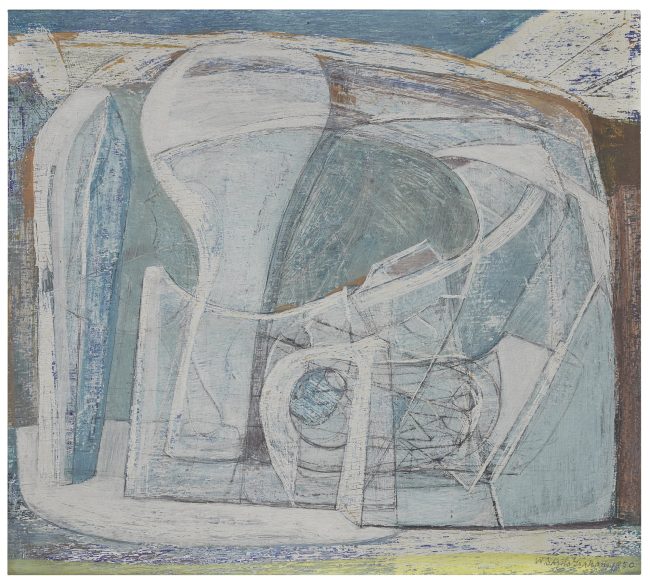Glacier Painting in Bowie Auction

Glacier (Bone), 1950, Oil on pencil on board, Private Collection Ex Sotheby's
Important Glacier painting from Davie Bowie Collection.
A wonderful example of Wilhelmina Barns-Graham’s glacier paintings is to be auctioned at Sothebys on 10 November 2016. The painting is part of David Bowie’s substantial art collection which is being sold off in a few weeks time. Glacier (Bone) is a smaller version of the great series of glacier paintings that are distributed in public collections around the UK, including Tate, the Scottish National Gallery of Modern Art and the British Council. Others are with Wolverhampton Art and Museum Services, Sheffield Galleries and Museum Trust, and Southampton Art Gallery.
Willie’s glacier paintings were the first works that caught the attention of galleries, critics and collectors. In the 1950s they led to her being regarded as one of the most imprtant abstract painters working in the country. They remain the work of first choice for many modern British art collectors and such a good example rarely comes on the open market. The provenance for this painting is that it was acquired directly from the artist by Theo Crosby R.A. in 1950, and was subsequently sold in an auction of his works by Phillips in 1996, which is where Bowie bought it.
The sales catalogue has this commentary:
Wilhelmina Barns-Graham visited the Grindelwald Glacier in Switzerland in May 1949, and the expedition was to prove a turning point in her artistic practice. The trip was a happy one, spent in the company of the Brotherton family, and she revelled in the vivid clarity of light and the clear, fresh air of the mountains. The physical beauty and presence of the icy landscape was a striking one: she later recalled vividly the ‘massive strength and size of the glaciers, the fantastic shapes, the contrast of solidity and transparency, the many reflected colours in strong light, the warmth of the sun melting and changing the forms…Enormous standing forms, polished like glass with sharp edges’ (the Artist, quoted in Lynne Green, W. Barns-Graham: A Studio Life, Lund Humphries, London, 2001, p.105).
In the glaciers, Barns-Graham discovered a new subject all her own, one which spurred a move into abstraction and from which a veritable outpouring of paintings, drawings and prints flowed. Despite the brevity of the trip, it was to prove a rich and lasting source of inspiration, and she returned again and again to the glacier theme over the years. Glacier (Bone) is a beautiful example of one of the series of ‘Glacier Abstractions’ paintings Barns-Graham produced following the trip, epitomising the critic J.P. Hodin’s view that in these works she ‘reached not only a material beauty…but also a musical beauty through abstract forms’ (J.P. Hodin, ‘Cornish Renaissance’, Penguin New Writing, no.39, 1950, p.122).
Comprised of complex layers, Glacier (Bone) captures the transience and translucence of the glacial ice with a remarkable fluency. Barns-Graham spoke of her wish to present not just an image of this landscape but the sensation of it: she sought to ‘combine in a work all angles at once, from above, through, and all round, as a bird flies, a total experience’ (the Artist, op. cit., p.105). Employing a cool, glassy palette she captures all elements of this landscape: the vast, static expanses of ice, the dark earth bordering it, the lemon-yellow light glancing off its smooth surface, the cracking and splintering of crystalline shards. The surface is intricately worked, layers of oil paint applied and scraped back, incised and shaped by sharp, interweaving lines of graphite. The result is a deftly captured landscape of remarkable freshness, still as exciting and relevant now as it was upon its creation over half a century ago.
